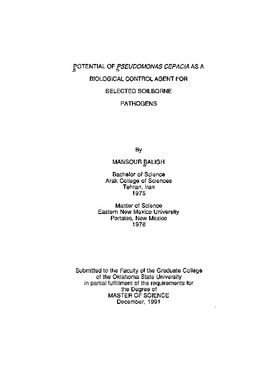| dc.description.abstract | At the beginning of the twenty-first century, biological control will be an alternative way to assist the development of agriculture. Biotechnology has been improving during the present decade; specifically, a great deal of information on molecular biology and interaction between host and pathogen has been acquired. Recently, some bacterial biocontrol agents have been commercially introduced, but this field of investigation cannot compete with the development of numerous pesticides because the performance for biocontrol agents is still inadequate for substitution of chemical control. Therefore, it will be a remarkable achievement if biocontrol agents can be substituted for hazardous, synthetic chemicals which damage the natural environment. For this reason, the attempts to introduce a new biocontrol agent will be beneficial to agriculture as well as the environment. The purpose of this research is to investigate the potential of Pseudomonas cepacia as a biocontrol agent, to study the P. cepacia I host I pathogen interaction, and to investigate factors involved in the enhancement of biocontrol to protect crops from soilborne diseases. The literature review looks at the previous and present investigations conducted on P. cepacia as biocontrol agent. Moreover, the review surveys similar aspects of closely related species of Pseudomonas. The focus of discussion is the phytopathogenic strains; however, some aspects of clinical and industrial strains of P. cepacia are mentioned in order to develop key points about the possible hazard to human health and the environment. Since the detection, identification, and pathogenicity of ammonia produced by P. cepacia will not be discussed in the literature chapter, additional information comparing this bacterium to other microorganisms producing ammonia during pathogenic interactions will be discussed. It is intended that'this effort find a convincing answer to the main question of whether or not P. cepacia is a beneficial or deleterious organism. | |
